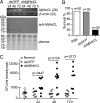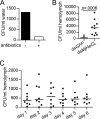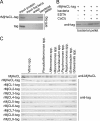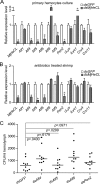A shrimp C-type lectin inhibits proliferation of the hemolymph microbiota by maintaining the expression of antimicrobial peptides
- PMID: 24619414
- PMCID: PMC4002086
- DOI: 10.1074/jbc.M114.552307
A shrimp C-type lectin inhibits proliferation of the hemolymph microbiota by maintaining the expression of antimicrobial peptides
Abstract
Some aquatic invertebrates such as shrimp contain low albeit stable numbers of bacteria in the circulating hemolymph. The proliferation of this hemolymph microbiota in such a nutrient-rich environment is tightly controlled in healthy animals, but the mechanisms responsible had remained elusive. In the present study, we report a C-type lectin (MjHeCL) from the kuruma shrimp (Marsupenaeus japonicus) that participates in restraining the hemolymph microbiota. Although the expression of MjHeCL did not seem to be modulated by bacterial challenge, the down-regulation of its expression by RNA interference led to proliferation of the hemolymph microbiota, ultimately resulting in shrimp death. This phenotype was rescued by the injection of recombinant MjHeCL, which restored the healthy status of the knockdown shrimp. A mechanistic analysis revealed that MjHeCL inhibited bacterial proliferation by modulating the expression of antimicrobial peptides. The key function of MjHeCL in the shrimp immune homeostasis might be related to its broader recognition spectrum of the hemolymph microbiota components than other lectins. Our study demonstrates the role of MjHeCL in maintaining the healthy status of shrimp and provides new insight into the biological significance of C-type lectins, a diversified and abundant lectin family in invertebrate species.
Keywords: Antimicrobial Peptides; C-type Lectin; Hemolymph Microbiota; Invertebrates; Lectin; Pattern Recognition Receptor; RNA Interference (RNAi); Shrimp.
Figures









Similar articles
-
Crustacean hemolymph microbiota: Endemic, tightly controlled, and utilization expectable.Mol Immunol. 2015 Dec;68(2 Pt B):404-11. doi: 10.1016/j.molimm.2015.06.018. Epub 2015 Jul 4. Mol Immunol. 2015. PMID: 26153452 Review.
-
Increased bacterial load in shrimp hemolymph in the absence of prophenoloxidase.FEBS J. 2009 Sep;276(18):5298-306. doi: 10.1111/j.1742-4658.2009.07225.x. Epub 2009 Aug 13. FEBS J. 2009. PMID: 19682072
-
A hepatopancreas-specific C-type lectin from the Chinese shrimp Fenneropenaeus chinensis exhibits antimicrobial activity.Mol Immunol. 2008 Jan;45(2):348-61. doi: 10.1016/j.molimm.2007.06.355. Epub 2007 Aug 6. Mol Immunol. 2008. PMID: 17675157
-
A galectin from the kuruma shrimp (Marsupenaeus japonicus) functions as an opsonin and promotes bacterial clearance from hemolymph.PLoS One. 2014 Mar 11;9(3):e91794. doi: 10.1371/journal.pone.0091794. eCollection 2014. PLoS One. 2014. PMID: 24618590 Free PMC article.
-
The functional relevance of shrimp C-type lectins in host-pathogen interactions.Dev Comp Immunol. 2020 Aug;109:103708. doi: 10.1016/j.dci.2020.103708. Epub 2020 Apr 17. Dev Comp Immunol. 2020. PMID: 32305304 Review.
Cited by
-
Mosquito C-type lectins maintain gut microbiome homeostasis.Nat Microbiol. 2016 May;1:16023. doi: 10.1038/nmicrobiol.2016.23. Epub 2016 Mar 14. Nat Microbiol. 2016. PMID: 27170846 Free PMC article.
-
A positive feedback loop between two C-type lectins originated from gene duplication and relish promotes the expression of antimicrobial peptides in Procambarus clarkii.Front Immunol. 2022 Oct 24;13:1021121. doi: 10.3389/fimmu.2022.1021121. eCollection 2022. Front Immunol. 2022. PMID: 36353630 Free PMC article.
-
Galectin CvGal2 from the Eastern Oyster (Crassostrea virginica) Displays Unique Specificity for ABH Blood Group Oligosaccharides and Differentially Recognizes Sympatric Perkinsus Species.Biochemistry. 2015 Aug 4;54(30):4711-30. doi: 10.1021/acs.biochem.5b00362. Epub 2015 Jul 24. Biochemistry. 2015. PMID: 26158802 Free PMC article.
-
RNA-seq as a powerful tool for penaeid shrimp genetic progress.Front Genet. 2014 Aug 28;5:298. doi: 10.3389/fgene.2014.00298. eCollection 2014. Front Genet. 2014. PMID: 25221571 Free PMC article. Review.
-
Host Defense Effectors Expressed by Hemocytes Shape the Bacterial Microbiota From the Scallop Hemolymph.Front Immunol. 2020 Nov 12;11:599625. doi: 10.3389/fimmu.2020.599625. eCollection 2020. Front Immunol. 2020. PMID: 33281827 Free PMC article.
References
-
- Kamada N., Seo S. U., Chen G. Y., Núñez G. (2013) Role of the gut microbiota in immunity and inflammatory disease. Nat. Rev. Immunol. 13, 321–335 - PubMed
-
- Fagutao F. F., Koyama T., Kaizu A., Saito-Taki T., Kondo H., Aoki T., Hirono I. (2009) Increased bacterial load in shrimp hemolymph in the absence of prophenoloxidase. FEBS J. 276, 5298–5306 - PubMed
Publication types
MeSH terms
Substances
Grants and funding
LinkOut - more resources
Full Text Sources
Other Literature Sources

